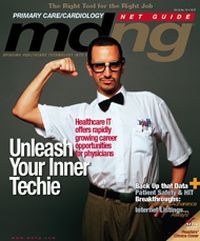Publication
Article
MDNG Primary Care
TechSectors: The Mobile Physician: Patient Data on the Go
Any physician will tell you that proper assessment and diagnosis of a patient is dependent upon review of a variety of information such as vital signs, EKG strips, medical images, and laboratory...
Any physician will tell you that proper assessment and diagnosis of a patient is dependent upon review of a variety of information such as vital signs, EKG strips, medical images, and laboratory tests. Obtaining and reviewing this information at the point of care is relatively straightforward. Unfortunately, physicians, especially specialists, are not always available at the point of care. A means of providing medical professionals with the ability to receive and respond to patient data while outside the medical facility has long been a challenge. Development of a robust system of communication providing detailed information remotely would be a major advancement in medical care. This is especially true, as we now know that rapid delivery of treatment can prevent further damage from occurring in various conditions.
Perhaps the earliest attempt to remedy this situation was the use of pagers, which first appeared at New York City’s Jewish Hospital in 1949. Early units simply alerted physicians of the need to call the hospital. Later units, like those still in use, provide limited alpha numeric data. Facsimile machines were the next advance, and, like pagers, are still widely used for medical communications. The fax machine provides the physician a means to receive a variety of pertinent patient data in hard copy format. Of course, use of this technology assumes that the physician can access a fax machine when required. Furthermore, with HIPAA regulations, one might question the ability to maintain patient confidentiality if the fax machine is outside the medical facility and if the hard copy itself is not properly handled or disposed of (see “The Bare Fax” in the November issue for more on this).
The broad availability of mobile cell phone technology combined with the improvement of cell phone networks has allowed instantaneous communication between medical facilities and physicians at any time of the day or night. However, cell phones only permit verbal communication and limited text communication through SMS, and do not allow the physician to receive and review graphical, pictorial, or printed data.
Internet capability has provided the greatest opportunity for advances in medical communication. Through secure networks and Web interfaces, physicians can review clinical data, such as CT scans and patient charts, at any computer with an Internet connection. However, the physician must have access at all times to a computer with a fast Internet connection in order for this technology to be beneficial. It is apparent that no single technology provides a total solution.
An ideal system would combine the beneficial aspects of these technologies and allow medical professionals to receive, review, and respond to medical data regardless of location. Such a system would be a benefit to patients, medical facilities, and physicians alike. For patients, expert medical opinion would always be available. Medical facilities, ERs, and other departments could become more efficient by always specialists available—even if they are not physically in the building. For physicians, the term “on-call” would take on new meaning. No longer would they be required to jump in the car and race to the hospital to evaluate critical diagnostic data; it could be delivered directly to them.
Currently, there are several products that attempt to utilize various technologies in this manner. Several EMR systems allow wireless handheld access from within medical facilities. These devices use secure wireless connections and allow physicians and other medical professionals access to patient data contained within the hospital system. Although this is indeed an advance in information handling, access is limited, and only data that has already been filed in the hospital system can be accessed. Recently collected information, such as a new EKG strip or x-ray, may not always be available.
Furthermore, physicians must search for the required data from extensive and often cumbersome databases through limited handheld interfaces. Another product recently introduced to the market combines key aspects of many of these technologies. The mVisum Medical Communication System permits delivery of high-quality DICOM images, Cine Loops, EKGs, CT scans, MRIs, and other data directly to the physician’s handheld computer or smartphone. According to the manufacturer, vital signs and other textual information can also be included in the delivered message, thus providing a complete picture of a patient’s condition. With this system, medical professionals at the point of care compile and send messages containing the most current patient data and information specific to the situation at hand. Unlike EMR systems, mVisum is designed to eliminate the need for the physician to sort through extensive lists of patients and files containing archived information.
The result is rapid delivery of pertinent information. Once the data is received and reviewed, physicians can respond to the messages via voice communication or by typing a return message. Advances in communication technology have opened the door for improved delivery of medical information. Medical facilities and medical professionals should evaluate the current technologies in order to find the most appropriate means to deliver the best care to their patients.
Mark Irish is a consultant with Katali, LLC, specializing in medical device marketing, product management, and new technology roll out. He has more than 20 years experience in product management and marketing of medical products.






